In this article
A successful day of ice climbing often comes down to one critical factor: how well you manage your hands. The search for a single, perfect glove that balances warmth and dexterity is a frustrating and fruitless quest. The real solution lies not in a product, but in a philosophy—a strategic, multi-glove system. This guide will dismantle the myth of the “magic bullet” glove and provide you with an expert-backed framework for building and mastering a personalized system that keeps your hands warm, dry, and functional from the approach to the final pitch.
This guide’s philosophy directly confronts the core problem of ice climbing handwear: the fundamental conflict between warmth and dexterity. It recognizes that the true enemy of warm hands is moisture, from both internal sweat and external wet ice. The ultimate solution, and our key takeaway, is this: stop searching for one perfect glove. Instead, learn to build and actively manage a strategic quiver of specialized gloves for every phase of your climb.
The Ice Climber’s Conundrum: Why Your Hands Really Freeze
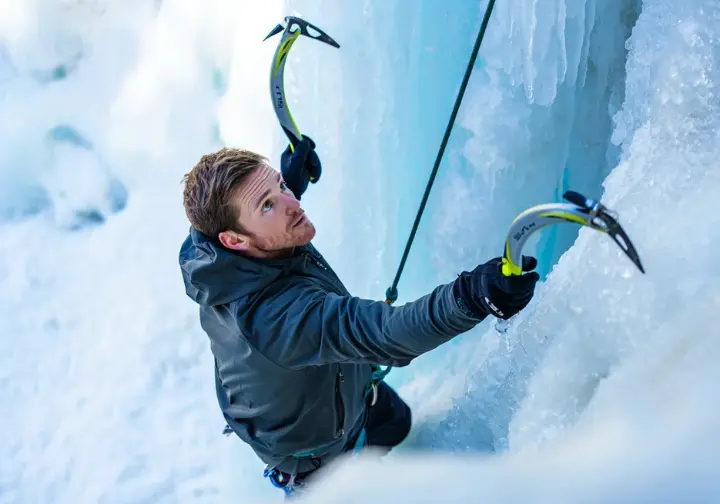
Before you can solve the problem of cold hands, you must understand the underlying principles at play. It’s a complex battle against physics, physiology, and the unforgiving environment of winter climbing. This section breaks down the science behind why your fingers get dangerously cold and introduces the strategic mindset required to win the fight.
The Inherent Warmth vs. Dexterity Conflict
The primary challenge for any ice climber is the direct trade-off between insulation and nimbleness. To keep hands warm, manufacturers add insulation, but insulation adds bulk, which severely limits the dexterity needed for crucial tasks like placing ice screws, clipping carabiners, or maintaining a sensitive feel on an ice tool. This conflict is the very heart of the ice climber’s glove problem, forcing a constant compromise between safety and performance.
In the world of technical ice and mixed climbing, some measure of warmth is almost always sacrificed for precision. A bulky glove might keep you warm at the belay, but it’s a liability when leading a difficult pitch where fumbling with gear is not an option. This is why a single-glove solution is destined to fail, as it cannot be optimized for both active and inactive periods. The consequences of this compromise are severe. Cold, numb fingers lead to a fumbling, insecure grip and can dramatically increase the risk of dropping a tool or making a critical mistake. This can also lead to premature fatigue, as you’re forced to over-grip your tools to compensate for the lack of feel, a direct result of The physical exertion of leading a pitch.
This reality often culminates in the infamous “screaming barfies”—the excruciating pain that accompanies the first rush of warm blood back into frozen fingers. This sensation is so intense it can be debilitating, making a climber feel nauseous and unable to focus, posing a significant safety risk high off the ground. The consensus among seasoned guides and alpinists is clear: the solution is not a single product, but an adaptable system. Embracing the philosophy behind glove systems for mountaineering is the first and most critical step toward solving the cold-hands puzzle and focusing on what matters: climbing safely and efficiently.
Moisture: The True Saboteur of Warmth
While biting wind and cold temperatures are the obvious adversaries, the true saboteur of hand warmth in the unforgiving environment of winter climbing is moisture. This threat comes from two fronts: externally from contact with wet ice, melting snow, and dripping water, and internally from the climber’s own sweat. A glove’s ability to manage this moisture is far more important than its sheer thickness. The moisture generated from within is particularly insidious. During the high-output exertion of leading a pitch, hands sweat, soaking the glove’s insulation from the inside out.
The core scientific principle is that water is a far more effective conductor of heat than air. Insulation works by trapping still air pockets to slow heat loss. When these air pockets become filled with water, the insulation’s function is catastrophically reversed—it begins to actively conduct heat away from the skin, rapidly accelerating heat loss. This thermal dynamic explains why a single, thick, insulated glove can ultimately make your hands colder than a thinner, dry glove would. It’s not just about getting wet; it’s about the complete failure of the insulation’s primary function.
This is also why a glove’s breathability is just as important as its waterproofness. A glove with a high-quality waterproof/breathable membrane can transport sweat vapor out, but this process can be overwhelmed during intense activity. The only truly effective way to combat this internal saturation is to swap to a fresh, dry pair of gloves. Learning effective glove system management is the most powerful technique for staying warm.
Anatomy of a Complete Glove System: Your Essential Quiver
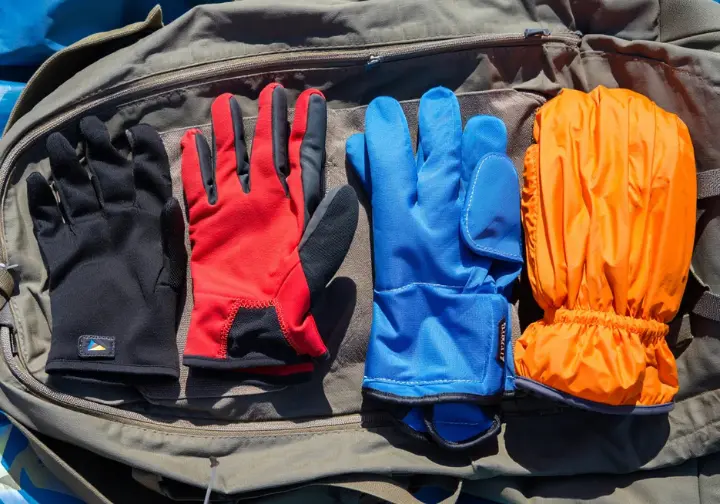
A functional glove system is not a random collection of handwear, but a modular toolkit designed for versatility. Each component has a specific job, allowing you to dynamically manage the competing demands of warmth, dexterity, and moisture throughout a climbing day. A comprehensive system is typically built around these four key components.
Component 1: The Liner Glove
The liner glove is the thin, snug-fitting foundation of the entire system, acting as a next-to-skin layer to manage moisture and provide a baseline of protection. Worn alone, liners are perfect for high-output activity like a strenuous approach hike or for high-dexterity tasks in milder temperatures, typically above 25°F / -4°C. When worn as a base layer inside heavier gloves, they add warmth by trapping an extra layer of air and, more importantly, wick sweat away from the skin.
Liners are typically made from quick-drying synthetics like fleece, Polartec® Powerstretch™, or merino wool blends. One of the liner’s key roles is solving the “damp hand problem.” Sliding a damp, bare hand into the narrow fingers of a fleece-lined lead glove is incredibly frustrating. A thin, smooth liner glides in easily, making glove changes fast and efficient. However, some climbers argue that adding a liner inside a perfectly snug lead glove can add just enough bulk to compress the hand, paradoxically making it colder. The decision depends on the fit of the outer glove; according to community discussions on ice climbing gloves fit advice, if the lead glove is slightly roomy, a liner can perfect the fit.
Component 2: The Lead Glove
This is the most specialized and critical component of the system, worn during the active phase of climbing. The lead glove’s absolute priority is dexterity and tactile feedback, allowing for the fine motor movements required to confidently place protection and feel secure on your ice tools. They are characterized by being lightly insulated and having a pre-curved, anatomical fit that mimics the natural shape of a hand gripping a tool. This ergonomic design reduces material bunching in the palm, which is a major cause of forearm pump.
Many advanced designs use body-mapped insulation, placing a thicker layer on the back of the hand and a thinner layer on the palm to maximize grip. Because they are thin and used during high-exertion activity, lead gloves are extremely susceptible to getting wet. For this reason, it is standard practice among experienced climbers to carry at least two pairs of lead gloves. This rotation is the cornerstone of effective glove management. When the first pair becomes damp, it is immediately swapped for a fresh, dry pair that has been kept warm inside the climber’s jacket. This disciplined exchange is the single most effective technique for maintaining warm, functional hands. The variety of gloves for ice climbing and mountaineering is vast, but all good lead gloves prioritize this balance.
Component 3: The Belay Glove/Mitt
While the lead glove is for moving, the belay glove is for waiting. During inactive periods like belaying, standing at a cold anchor, or rappelling, warmth becomes the absolute priority. The belay glove’s sole purpose is to provide maximum insulation to trap heat and allow hands to recover. These are heavily insulated gloves or, more commonly, mittens. A mitten design is warmer than a comparable glove because it keeps the non-thumb fingers together, allowing them to share radiant heat.
An efficient climber will immediately remove their damp lead gloves upon reaching an anchor, place them inside their jacket, and pull on their warm, dry belay mitts. This habit prevents hands from getting dangerously cold during static periods. Belay mitts should always be sized generously for more dead air space and to make them easy to pull on. A popular and cost-effective strategy is to use inexpensive but durable leather work gloves or mitts for belay duty. This saves the more delicate technical lead gloves from the significant wear and tear caused by rope handling.
Component 4: The Emergency Mitt
The final component of a truly comprehensive system is the emergency mitt, the warmest piece of handwear in your pack. This is not a glove for active use but a crucial piece of safety equipment reserved for the most severe conditions or unexpected situations. They are your ultimate safety net, deployed in the face of extreme cold, during an unplanned night out, or in any emergency where preventing frostbite becomes the overriding concern.
Emergency mitts are typically expedition-weight, built for the harshest environments. They almost always feature a modular design with a very thick, removable insulated liner and a durable, protective outer shell. Dexterity in these mitts is extremely limited; they are designed only for basic survival tasks. For most climbs, the emergency mitts will remain in the bottom of your pack. Their value lies not in frequent use, but in their presence as an ultimate fail-safe.
The Science of Handwear: Materials and Technology Explained

Understanding the technology inside a modern climbing glove helps you cut through marketing hype and make informed decisions. A glove’s performance is determined by the specific interplay between its insulation, waterproof membrane, and palm material.
Insulation Intelligence: The Engine of Warmth
Insulation works by trapping air in still pockets; the more air it traps, the better it insulates. In the damp world of ice climbing, synthetic insulations like PrimaLoft® are the dominant choice because of their superior performance when wet. A comprehensive guide to Primaloft synthetic insulation reveals it was developed for the U.S. Army as a water-resistant alternative to down and maintains significant warmth even when saturated.
Not all PrimaLoft® is the same. PrimaLoft® Gold offers the highest warmth-to-weight ratio. PrimaLoft® Gold with Cross Core™ infuses fibers with Aerogel for exceptional warmth with less bulk. PrimaLoft® Gold Eco Grip Control is a specialized, less-lofty version designed for the palm to ensure a secure grip without material bunching. Fleece is another staple, valued for being soft, warm, and exceptionally quick-drying. Wool, particularly Merino wool, is nature’s original performance fiber, prized for its ability to insulate even when damp. A glove’s insulation is often measured in grams per square meter (g/m²), but the specific type is as important as the weight.
The Waterproofing Reality: Membranes and Misconceptions
True waterproofness comes from a microporous membrane—a thin layer with pores large enough for sweat vapor to escape but too small for liquid water to enter. GORE-TEX® is the market leader, but many brands like Black Diamond (BD.dry™) have excellent proprietary membranes. For climbers, a key innovation is found in GORE-TEX Grip Gloves. This technology bonds the outer shell, waterproof membrane, and liner together, eliminating movement and dramatically improving dexterity on an ice tool.
A crucial point of failure is “wetting out.” The waterproof membrane is an internal layer. The outer fabric is treated with a Durable Water Repellent (DWR) finish. When this DWR wears off, the outer fabric absorbs water. A wetted-out glove feels heavy, gets cold from evaporative cooling, and its breathability plummets. Even though your hand may remain technically dry, the glove’s overall performance is severely degraded. This underscores the importance of both a glove-swapping system and regular maintenance of the DWR coating on your gloves. This “wetting out” problem also explains the popularity of a glove like the Showa Temres 282, whose outer polyurethane shell is physically impermeable.
The Tactile Interface: Palm Materials
The palm of the glove is your direct connection to your tools and the ice. Goatskin leather is the material of choice for most high-end climbing gloves due to its excellent combination of suppleness, strength, and abrasion resistance. Some gloves feature advanced, performance-enhanced leathers from companies like Pittards®. Pittards® WR100X water-resistant leather is a specialized tanning process that permanently bonds water resistance into the leather’s fiber structure, ensuring it stays soft and grippy even when wet.
Another key Pittards® innovation is Armor-Tan® Technology. This process impregnates the leather with microscopic ceramic particles, which dramatically increases its abrasion resistance. This is a direct solution to the common complaint of gloves wearing out in the palm and fingers after only a season of use. Synthetic palm materials like polyurethane, found on gloves like the Showa Temres, offer a different value proposition. They provide absolute waterproofness and outstanding grip at a very low cost, but trade-offs typically include lower long-term durability and significantly reduced breathability.
The 2025 Ice Climbing Glove System: Expert-Vetted Recommendations

Applying the principles of the glove system, we’ve selected top-performing gloves for each critical role. These recommendations are based on a synthesis of technical specifications, real-world user feedback from guides, and their suitability within a versatile system.
Best Lead Gloves (Maximum Dexterity & Feel)
These are the specialized “workhorse” gloves where a sensitive connection to your tools is paramount. Remember to carry two pairs and rotate them.
Black Diamond Punisher | A workhorse balancing warmth and excellent dexterity for technical leads
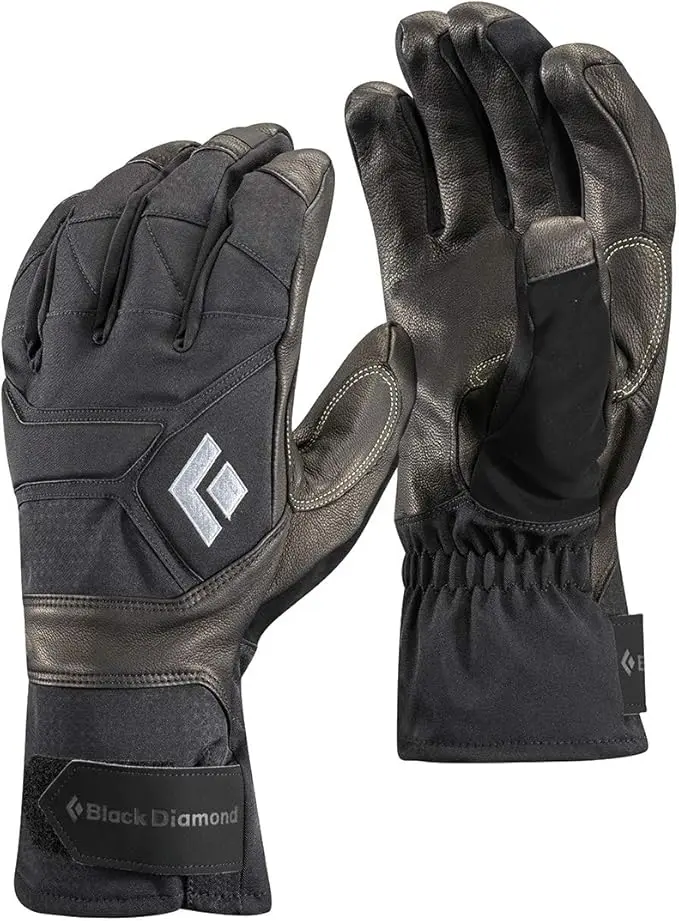
The Punisher is a perennial favorite for good reason, offering a fantastic balance of warmth, protection, and the dexterity needed for hard leads. It features 100g PrimaLoft® Gold insulation on the back of the hand for warmth, paired with a tough goatskin leather palm for grip. The waterproof BD.dry™ insert keeps hands dry from wet ice, and the pre-curved, ice-tool-specific fit feels secure and ergonomic right out of the box.
Users consistently praise its exceptional dexterity, allowing for confident handling of screws and ropes. The balance of warmth and precision makes it a versatile choice for a wide range of winter conditions. However, a significant and recurring complaint is that the inner fleece liner can pull out when removing damp hands, making the glove difficult to put back on in the cold. Some also find the fingers to be cut narrow, so trying them on is highly recommended. Despite this, for many climbers, it remains the go-to glove for technical leads.
PROS
- Exceptional dexterity for technical tasks.
- Great balance of warmth and precision.
- Reliably waterproof and durable build.
CONS
- Inner liner is prone to pulling out.
- Fit can be inconsistent or too narrow.
- Not warm enough for long, static belays.
CAMP Geko Guide | A fantastic compromise of warmth and precision with a secure grip
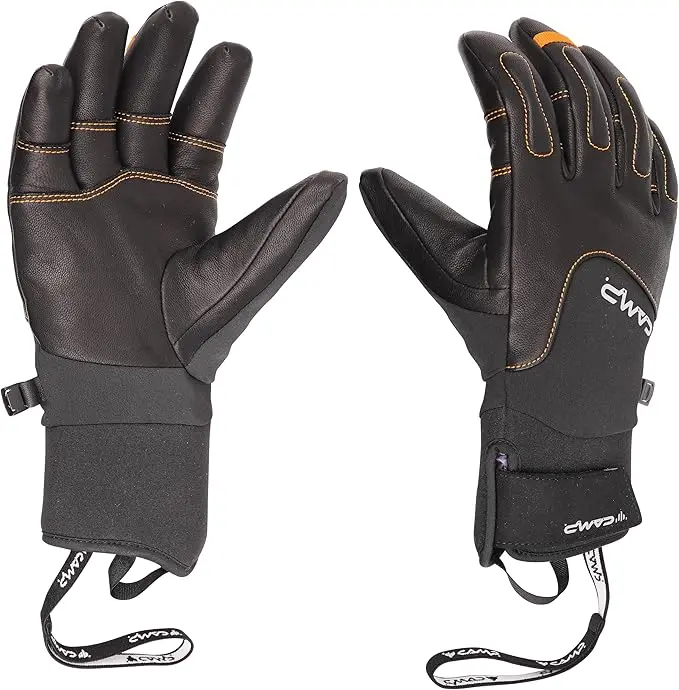
The CAMP Geko Guide is another top contender, built with a robust goatskin exterior and a focus on a precise, secure grip. It features a waterproof DRYZONE® membrane and is body-mapped with 100 g/m² PrimaLoft® Gold on the back and 60 g/m² PrimaLoft® Gold Eco Grip Control on the palm. This provides warmth where you need it without compromising the sensitive feel required for placing gear. The pre-shaped “Dart Finger” construction eliminates side seams for incredible comfort and dexterity.
Its precision and feel are highly praised by technical climbers who need confidence when handling tools and ropes. The construction is generally considered very durable. The primary drawback noted by users is inconsistent sizing, with some finding the fit, particularly in the fingers, to be tight or narrow. Sizing up is a common recommendation. For those who can dial in the fit, the Geko Guide is a superb technical glove that excels on demanding routes.
PROS
- Precise grip and excellent dexterity.
- Good balance of warmth and sensitivity.
- Durable goatskin and reliable waterproofing.
CONS
- Sizing can be inconsistent or too tight.
- Not warm enough for extreme static cold.
- Knuckle protectors can feel a bit stiff.
Hestra Ergo Grip Active | Unmatched dexterity and ergonomic fit, but with known durability issues
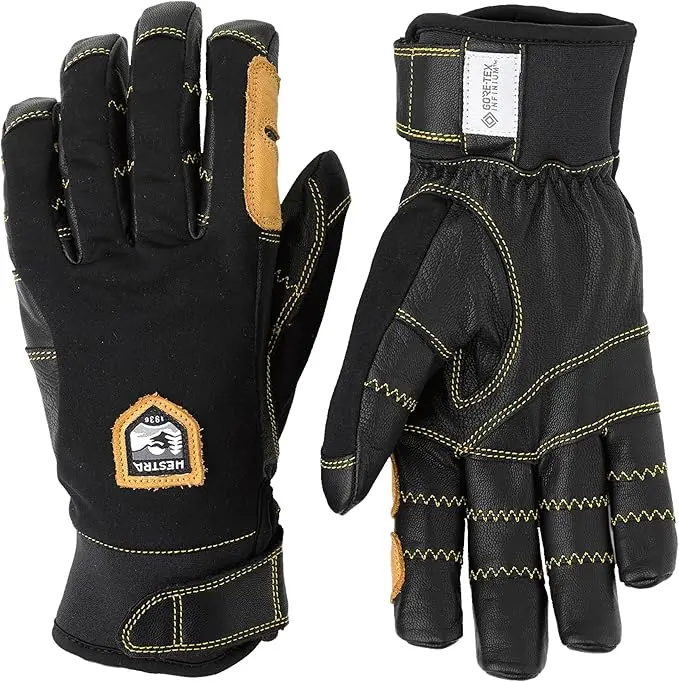
For climbers who prioritize absolute dexterity above all else, the Hestra Ergo Grip Active is in a class of its own. Its patented pre-curved design with minimal excess material provides a “second skin” feel that allows for incredible fingertip sensitivity. The backhand is made of windproof GORE-TEX Infinium™, and the palm is durable goatskin. This glove allows you to perform intricate tasks that would be impossible with almost any other insulated glove.
The trade-off for this unparalleled dexterity is durability and weather protection. A significant number of users report that the stitching wears out too quickly for such an expensive glove. It is also windproof and water-resistant, not fully waterproof, so it can soak through in prolonged wet conditions. It’s not warm enough for static belays in the cold, but for dry, technical leading where every bit of feel matters, its dexterity is unmatched.
PROS
- Unmatched dexterity and a second-skin feel.
- Excellent ergonomic, pre-curved fit.
- Effective wind protection for active use.
CONS
- Overall durability, especially stitching, is a concern.
- Not fully waterproof, only water-resistant.
- Not warm enough for static use or deep cold.
Best Belay Gloves & Mitts (Maximum Warmth)
When you’re static at an anchor, warmth is the only thing that matters. These are your personal re-warming stations.
Black Diamond Guide | Legendary warmth and bombproof durability for the coldest conditions
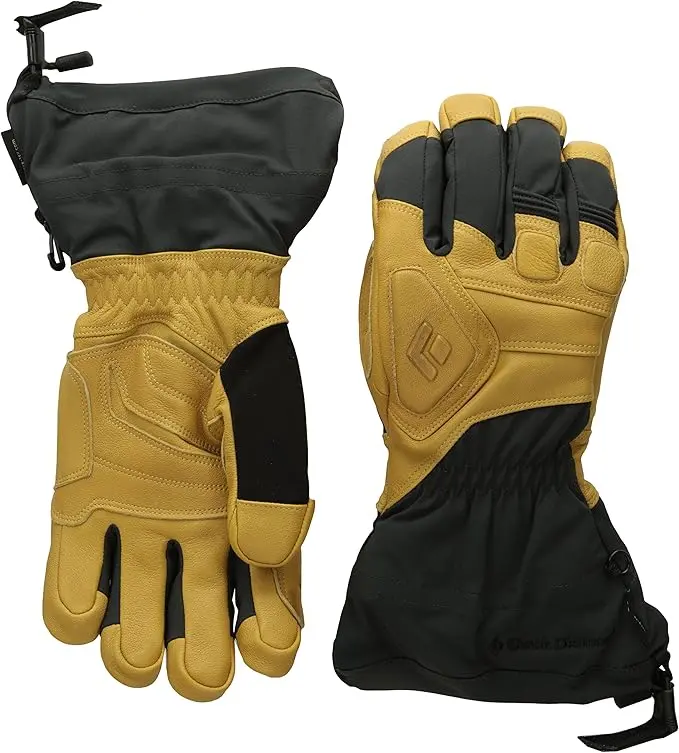
The Black Diamond Guide is a legend in the alpine world, revered for its exceptional warmth and bombproof durability. It’s the glove you bring when conditions are seriously cold and wet. It features a removable liner system with 170g PrimaLoft Gold and boiled wool, all wrapped in a tough nylon and goatskin shell with a GORE-TEX insert. The combination provides an incredible amount of insulation for long, static belays in frigid temperatures.
Users almost universally praise its warmth and durability, with many reporting it lasts for seasons of hard use. The removable liner is a huge plus for drying on multi-day trips. The main downsides are its bulk and a necessary break-in period; it’s stiff out of the package. Some also find the liner can get twisted or pull out when removing damp hands. It’s overkill for mild days, but for the coldest conditions, it’s a piece of professional-grade equipment that provides total confidence.
PROS
- Exceptionally warm for extreme cold.
- Bombproof durability for seasons of use.
- Removable liner aids in quick drying.
CONS
- Removable liner can pull out or tangle.
- Requires a significant break-in period.
- Bulky, limiting fine motor dexterity.
Outdoor Research Alti II GORE-TEX Mitts | Expedition-level warmth, your ultimate safety net for extreme cold
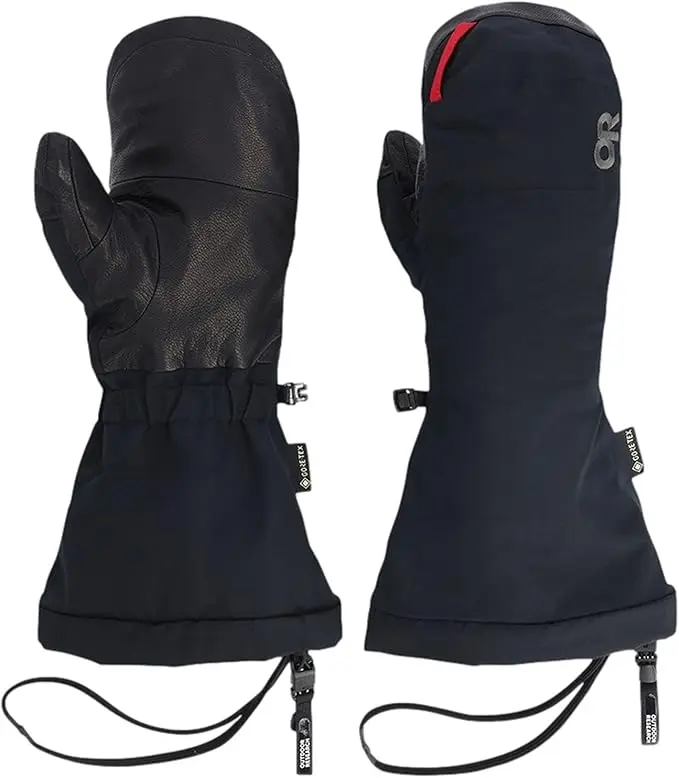
When warmth is a matter of survival, you reach for the OR Alti II Mitts. These are expedition-level mitts designed for 8,000-meter peaks and Arctic conditions, making them the ultimate emergency or belay mitt for any climber. The system is modular, with a GORE-TEX outer shell and a massively insulated, removable PrimaLoft Gold liner (340g). The Pittards® Armortan® leather palm adds incredible durability.
There is no question about their warmth; users consistently report toasty hands in temperatures far below zero Fahrenheit. Their modularity is also a key benefit, allowing for quick drying and versatile use. As expected, dexterity is extremely limited—these are not for climbing. They are bulky and expensive. But as your ultimate safety net for the absolute worst-case scenarios or for belaying in brutal cold, the Alti II Mitts are an essential piece of safety gear.
PROS
- Unbeatable warmth for expedition use.
- Extremely durable leather and Kevlar build.
- Modular system with a removable liner.
CONS
- Very bulky with extremely limited dexterity.
- Too warm for anything but severe cold.
- Premium price represents a big investment.
Kinco Pigskin Mitts | The high-value workhorse: incredibly durable and surprisingly warm for belaying
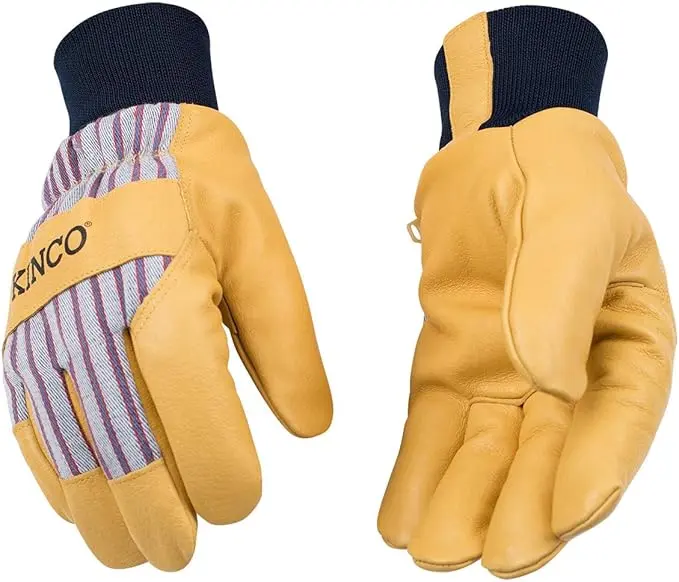
The Kinco Pigskin Mitt is a cult classic in the ski and climbing worlds for one reason: it offers an unbelievable warmth-and-durability-to-cost ratio. These are tough, insulated work mitts made from durable pigskin leather with a Heatkeep® thermal lining. What makes them surprisingly dexterous is that the insulation is shaped like a 5-finger glove inside the mitt shell.
Users are consistently shocked by how warm and durable these mitts are for their very low price, often outperforming much more expensive options. The main drawback is that they are not inherently waterproof and require regular treatment with a wax sealant (like the included Nikwax packet) to stay dry. The liner can also be prone to pulling out. But as a dedicated, durable, and shockingly warm belay mitt that you don’t have to worry about abusing, the Kinco is arguably the best value in outdoor handwear.
PROS
- Incredible value for the price point.
- Surprisingly warm even in sub-zero temps.
- Bombproof durability from pigskin leather.
CONS
- Requires frequent wax treatment to be waterproof.
- Inner liner is prone to pulling out.
- Bulky, limiting fine motor skills.
Best Value & Disruptor Gloves
These gloves, often from outside the traditional climbing industry, have earned a cult following for their exceptional performance-to-price ratio.
Showa Temres 282 | The $25 “miracle glove” that is completely waterproof and grippy
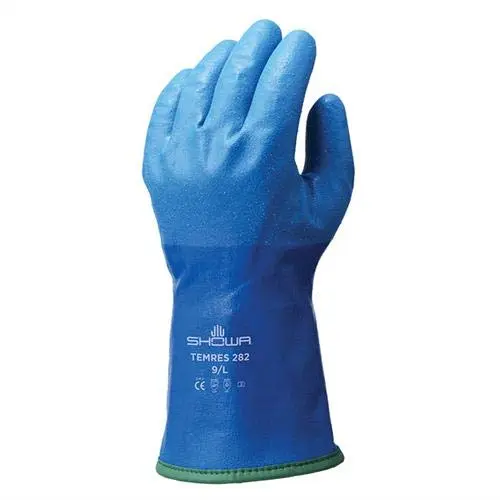
The Showa Temres 282 has achieved legendary status among ice climbers and outdoor enthusiasts. It’s an industrial glove with a unique micro-ventilated polyurethane coating that is completely waterproof yet breathable. Paired with a seamless acrylic liner, it offers a combination of features that is hard to find in gloves costing five times as much. The rough-textured grip is outstanding on wet tools and ice.
Users rave about its true waterproofness, exceptional grip, and the surprising balance of warmth and dexterity it provides for active use. For its low price, the performance is phenomenal. The downsides? The fixed liner takes a long time to dry if it gets wet from sweat, making it less ideal for multi-day trips. It also cools down quickly when you’re not moving, and the bright blue “Smurf” color isn’t for everyone. Sizing can run small, so most users recommend going up one or even two sizes. For wet, single-pitch ice cragging, it’s a brilliant and affordable solution.
PROS
- Truly waterproof yet breathable design.
- Exceptional grip on wet or dry surfaces.
- Incredible performance for its low price.
CONS
- Fixed liner takes a long time to dry.
- Not warm enough for static belays.
- Sizing runs small; short finger length.
Kinco Deerskin Leather Cold Protection | The perfect, durable, and inexpensive dedicated belay and rappel glove

This is another gem from Kinco, often sold as model 90HK. It’s a work glove made from premium full-grain deerskin, which is naturally soft, pliable, and offers excellent dexterity. Combined with Heatkeep® thermal insulation, it’s a remarkably comfortable and warm glove for its low profile. The ergonomic design and soft leather provide a level of dexterity that is fantastic for handling ropes.
Its primary role in a climber’s system is as an inexpensive, durable, and dexterous belay and rappel glove. It’s far more durable than expensive lead gloves for rope-handling duty, and much more dexterous than a bulky belay mitt. Like other Kincos, its main limitation is a lack of inherent waterproofness; it requires diligent wax treatment to fend off moisture. But for its price, comfort, and durability in a high-wear role, it’s an unbeatable value.
PROS
- Excellent dexterity from soft deerskin.
- Very warm, comfortable, and durable.
- Exceptional value for belay/rappell use.
CONS
- Needs frequent wax treatment for water resistance.
- Can get sweaty during high-exertion.
- Less ideal for very wet conditions.
Putting It All Together: Building and Mastering Your System
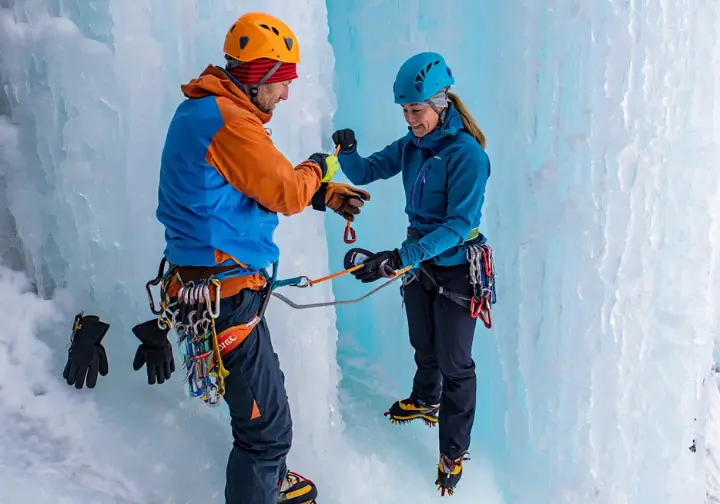
A great collection of gloves is useless without the knowledge and discipline to manage it effectively. This section provides practical advice for tailoring a system to your needs and developing the habits that will keep your hands warm.
The Art of the Perfect Fit
Across countless reviews and forums, the most repeated advice is that fit is the single most important factor in a glove’s performance. An ill-fitting glove, no matter how expensive, will fail you. A glove that is too tight will constrict blood flow, leading to rapid cooling and numbness. There should be no pressure points across the knuckles when you make a fist. Conversely, a glove that is too loose will have excess material at the fingertips, compromising dexterity and forcing you to over-grip your tools, leading to debilitating forearm pump.
When trying on gloves, always test them for the task. For a lead glove, grip an object to simulate holding an ice tool; your fingers should just graze the end. For a belay mitt, ensure there is enough room to easily slide it on. As many threads on ice climbing gloves advice suggest, if you plan to use liners, you must try on the outer gloves with the specific liner you intend to use.
System Blueprints for Common Scenarios
Building a system is about matching your gear to your objective. A casual day at the local ice park has very different demands than a long, committing alpine route. Here are two sample systems.
- The Single-Pitch Cragging Kit (Focus on Efficiency & Value):
- Lead Glove: One primary pair. The Showa Temres 282 is an excellent choice for its waterproofness and value.
- Belay Mitt: A durable and inexpensive option like the Kinco Pigskin Mitts. Keep a chemical hand warmer inside for a welcome heat boost.
- The Multi-Pitch Alpine Route Kit (Focus on Versatility & Safety): For climbers who are confused about glove systems, this is a solid template.
- Approach Glove: A light softshell or simple leather work glove.
- Lead Gloves: Two pairs of a high-performance model like the Black Diamond Punisher or CAMP Geko Guide.
- Belay Glove: A warmer, more robust glove like the Black Diamond Guide.
- Emergency Mitt (In the Pack): A non-negotiable safety item like the Outdoor Research Alti II.
Pro Tips: The Art of Glove Management
A great system is useless without the discipline to manage it. These habits, confirmed by countless ice climbing gloves recommendations from experienced climbers, are what make the system work.
- Pre-warming: Never put on a cold glove. The pair you intend to wear next should always be stored inside your jacket, ideally in an internal pocket or tucked into your base layer.
- The Disciplined Swap: Be religious about this. The moment you are secure at the anchor, swap your damp lead gloves for your warm belay mitts. The moment you are ready to climb again, swap back.
- Leather Care: Leather is a natural material that requires care. Regularly treat your gloves with a wax-based sealant. This process replenishes the DWR, prevents the leather from “wetting out,” and keeps it supple, dramatically extending its life. This is a core principle of good gear stewardship, similar to climbing shoe care.
- Drying Techniques: At the end of the day, proper drying is crucial. Never use direct, high heat. A gentle boot dryer is ideal, but simply hanging them in a dry room works. In the field, place liners and shells inside your sleeping bag with you overnight; your body heat will safely dry them.
The End of Cold Hands: Key Takeaways for Your Glove System
The persistent challenge of keeping hands warm and functional while ice climbing isn’t solved by a single purchase, but by a shift in mindset. The only reliable solution is a personalized, actively managed glove system.
- Embrace the System: The “magic bullet” glove doesn’t exist. The key is to assemble a quiver of handwear—liners, lead gloves, and belay mitts—each chosen for a specific purpose.
- Moisture is the Enemy: Your primary goal is moisture management. This means combating sweat from the inside and water from the outside through disciplined glove swapping.
- Active Management is Key: A system is only as good as your discipline in using it. Pre-warm your gloves inside your jacket and be diligent about swapping between your lead and belay pairs at every transition.
- Fit is Everything: A glove that is too tight restricts blood flow and makes you colder. A glove that is too loose compromises dexterity and causes fatigue. Prioritize a perfect fit.
- Invest in Knowledge, Not Just Gear: By understanding these principles, you can build a setup that enhances your performance, safety, and enjoyment on the ice, finally putting an end to the era of cold hands.
Frequently Asked Questions about Ice Climbing Glove Systems
Can I just use my ski gloves for ice climbing? +
What are the “screaming barfies” and how do I prevent them? +
How many pairs of gloves should I carry for a typical day of multi-pitch ice climbing? +
How do I re-waterproof my leather climbing gloves? +
We are a participant in the Amazon Services LLC Associates Program, an affiliate advertising program designed to provide a means for sites to earn advertising fees by advertising and linking to Amazon.com. As an Amazon Associate I earn from qualifying purchases. We also participate in other affiliate programs. The information provided on this website is provided for entertainment purposes only. We make no representations or warranties of any kind, expressed or implied, about the completeness, accuracy, adequacy, legality, usefulness, reliability, suitability, or availability of the information, or about anything else. Any reliance you place on the information is therefore strictly at your own risk. Additional terms are found in the terms of service.











